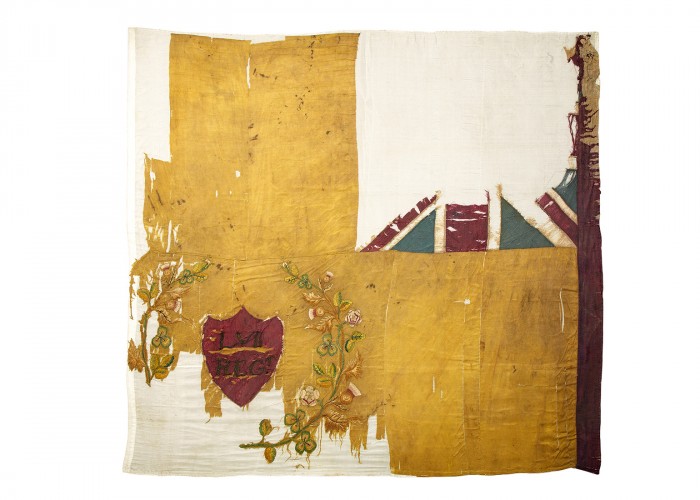Regimental Colour, 57th (West Middlesex) Regiment
This is the colour (flag) carried by the British 57th (Middlesex) Regiment at the Battle of Albuera, in 1811. This was a crucial battle during the long Peninsular War in Spain and Portugal, and British victory eventually led to Napoleon’s final defeat at the Battle of Waterloo, in 1815.
This colour is so damaged because of the incredibly brutal fighting at Albuera, during which the 57th Regiment took horrific casualties. This colour of the 57th Foot was hit by 21 shots and had its staff broken by enemy fire at the Battle of Albuera (16 May 1811) during the Peninsular War (1807-14).
An infantry regiment normally had (and still has) two colours or flags: a King’s (or Queen’s) Colour and a Regimental Colour. In battle they served as a rallying point and were the focus of regimental pride. To lose a colour to the enemy was the greatest disgrace a regiment could suffer and soldiers defended the colours with their lives.
In relation to the numbers involved, Albuera was the bloodiest battle of the Peninsular War. General William Beresford had been sent by Wellington to besiege the border town of Badajoz. When a French Army under Marshall Soult advanced to relieve the siege Beresford moved to meet him at Albuera.
A feint by Soult put the centre of Beresford’s army under a massive flanking attack which was supported by artillery and Polish lancers. A storm of shot tore into the British ranks and the 57th Foot suffered particularly severely. The commanding officer, Lieutenant Colonel William Inglis, was hit by a shot which pierced his left breast and lodged in his back (the shot is now in the National Army Museum). He remained with the regiment’s colours and encouraged his men with the words: “Die hard, 57th, die hard.”
Elsewhere, three British battalions were overwhelmed by shot, musket fire and lancers. They lost four colours and the staffs of two others. The two young ensigns of the 66th (Berkshire) Regiment of Foot, who were responsible for carrying their colours, died defending them.
A counter-attack saved the day and the French were eventually defeated but at great cost to both sides. The 57th lost 88 per cent of its officers and 75 per cent of its men either killed or wounded. From that day on the 57th were known as the ‘Die Hards’.
-
Curatorial info
- Originating Museum: National Army Museum
- Accession Number: NAM. 1965-02-165-1
- Material: Silk, cotton
-
Use this image
You can download and use the high resolution image under a Creative Commons licence, for all non-commercial purposes, provided you attribute the copyright holder.
- Rights Holder: Copyright National Army Museum. Photography Relic Imaging Ltd.
- License Type: Creative Commons
Find it here
This object is in the collection of National Army Museum








